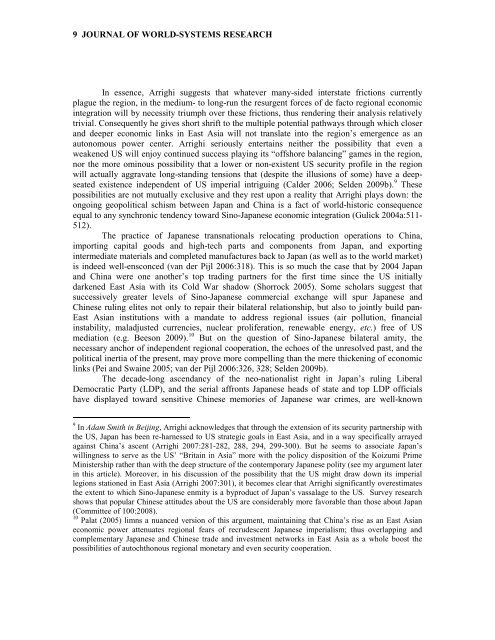Entire Volume 17 issue 1 - Journal of World-Systems Research ...
Entire Volume 17 issue 1 - Journal of World-Systems Research ...
Entire Volume 17 issue 1 - Journal of World-Systems Research ...
You also want an ePaper? Increase the reach of your titles
YUMPU automatically turns print PDFs into web optimized ePapers that Google loves.
9 JOURNAL OF WORLD-SYSTEMS RESEARCH<br />
In essence, Arrighi suggests that whatever many-sided interstate frictions currently<br />
plague the region, in the medium- to long-run the resurgent forces <strong>of</strong> de facto regional economic<br />
integration will by necessity triumph over these frictions, thus rendering their analysis relatively<br />
trivial. Consequently he gives short shrift to the multiple potential pathways through which closer<br />
and deeper economic links in East Asia will not translate into the region’s emergence as an<br />
autonomous power center. Arrighi seriously entertains neither the possibility that even a<br />
weakened US will enjoy continued success playing its “<strong>of</strong>fshore balancing” games in the region,<br />
nor the more ominous possibility that a lower or non-existent US security pr<strong>of</strong>ile in the region<br />
will actually aggravate long-standing tensions that (despite the illusions <strong>of</strong> some) have a deep-<br />
seated existence independent <strong>of</strong> US imperial intriguing (Calder 2006; Selden 2009b). 9<br />
The practice <strong>of</strong> Japanese transnationals relocating production operations to China,<br />
importing capital goods and high-tech parts and components from Japan, and exporting<br />
intermediate materials and completed manufactures back to Japan (as well as to the world market)<br />
is indeed well-ensconced (van der Pijl 2006:318). This is so much the case that by 2004 Japan<br />
and China were one another’s top trading partners for the first time since the US initially<br />
darkened East Asia with its Cold War shadow (Shorrock 2005). Some scholars suggest that<br />
successively greater levels <strong>of</strong> Sino-Japanese commercial exchange will spur Japanese and<br />
Chinese ruling elites not only to repair their bilateral relationship, but also to jointly build pan-<br />
East Asian institutions with a mandate to address regional <strong>issue</strong>s (air pollution, financial<br />
instability, maladjusted currencies, nuclear proliferation, renewable energy, etc.) free <strong>of</strong> US<br />
mediation (e.g. Beeson 2009).<br />
These<br />
possibilities are not mutually exclusive and they rest upon a reality that Arrighi plays down: the<br />
ongoing geopolitical schism between Japan and China is a fact <strong>of</strong> world-historic consequence<br />
equal to any synchronic tendency toward Sino-Japanese economic integration (Gulick 2004a:511-<br />
512).<br />
10<br />
But on the question <strong>of</strong> Sino-Japanese bilateral amity, the<br />
necessary anchor <strong>of</strong> independent regional cooperation, the echoes <strong>of</strong> the unresolved past, and the<br />
political inertia <strong>of</strong> the present, may prove more compelling than the mere thickening <strong>of</strong> economic<br />
links (Pei and Swaine 2005; van der Pijl 2006:326, 328; Selden 2009b).<br />
The decade-long ascendancy <strong>of</strong> the neo-nationalist right in Japan’s ruling Liberal<br />
Democratic Party (LDP), and the serial affronts Japanese heads <strong>of</strong> state and top LDP <strong>of</strong>ficials<br />
have displayed toward sensitive Chinese memories <strong>of</strong> Japanese war crimes, are well-known<br />
9 In Adam Smith in Beijing, Arrighi acknowledges that through the extension <strong>of</strong> its security partnership with<br />
the US, Japan has been re-harnessed to US strategic goals in East Asia, and in a way specifically arrayed<br />
against China’s ascent (Arrighi 2007:281-282, 288, 294, 299-300). But he seems to associate Japan’s<br />
willingness to serve as the US’ “Britain in Asia” more with the policy disposition <strong>of</strong> the Koizumi Prime<br />
Ministership rather than with the deep structure <strong>of</strong> the contemporary Japanese polity (see my argument later<br />
in this article). Moreover, in his discussion <strong>of</strong> the possibility that the US might draw down its imperial<br />
legions stationed in East Asia (Arrighi 2007:301), it becomes clear that Arrighi significantly overestimates<br />
the extent to which Sino-Japanese enmity is a byproduct <strong>of</strong> Japan’s vassalage to the US. Survey research<br />
shows that popular Chinese attitudes about the US are considerably more favorable than those about Japan<br />
(Committee <strong>of</strong> 100:2008).<br />
10 Palat (2005) limns a nuanced version <strong>of</strong> this argument, maintaining that China’s rise as an East Asian<br />
economic power attenuates regional fears <strong>of</strong> recrudescent Japanese imperialism; thus overlapping and<br />
complementary Japanese and Chinese trade and investment networks in East Asia as a whole boost the<br />
possibilities <strong>of</strong> autochthonous regional monetary and even security cooperation.





